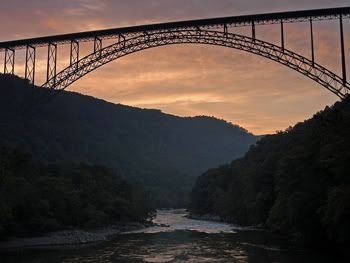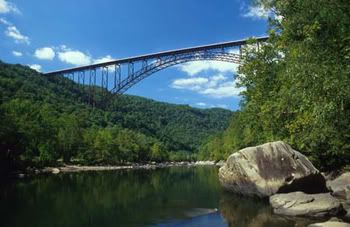
New River Gorge Bridge at Sunset from Above
The day my readers have been anticipating has finally arrived! At last, it's June 20th! Yeahhhh! What is significant about June 20th, you're asking? Well, I'll tell you:
1) Today, at 11:59 PM, it officially becomes summer! That's right, the summer solstice is sweeping around the globe at this very minute! Over on the western side of the International Date Line (in the Eastern Hemisphere (isn't that confusing?), summer is moving westward past New Zealand and Australia (where it's actually winter now, for even more confusion). But here in the North, it's summer! It's on the move. It's coming!

New River Gorge Bridge Sunset from the River
2) In honor of the change of seasons, I have switched my header and footer graphics. The header is now the full summer image, and I'm offering my readers a CONTEST! The first reader that figures out what river is pictured in the header wins a $50 Gift Certificate to the Restaurant or Online Store of your choice. You win it, you pick it! The footer has also changed, it's autumn, to reflect the flow of the seasons down the page. In 90 days, it becomes a full-fledged header of it's own, and then you'll get a glimpse of winter and the most awe-inspiring header of them all, to appear on MTMD in just 180 days.

New River Bridge from the River at Day
3) And most significantly for me, it's the weekend. Tonight I head up to West Virginia for my first rafting trip on the New River since last fall! I've been rafting since 1996, and although I have worked for a rafting company for the last year and a half here in the mountains of North Carolina, my whitewater home is still on the New and Gauley Rivers southern West Virginia. Can anyone sing me a chorus of Country Roads?
Almost heaven,
West Virginia.
Blue Ridge Mountains
Shanandoah River.
Life is old there
older than the trees
younger than the mountains
blowing like a breeze
Country Roads
take me home
to the place
I belong.
West Virginia!
Mountain Mama.
Take me home
country roads.
All my bags are packed, I'm ready to go...oops, wrong John Denver song. Anyway, you get the idea! I'm excited!
For all my friends on EntreCard, internet access will be sketchy...I hope you don't mind too much if I don't drop on you over the weekend, I'm going to try, but I'll probably just catch a few of you.
And now, as a parting gift to give you plenty to read over the long weekend, please enjoy the following tome on the season known as summer, kicked off with the Summer Solstice:
People around the world have observed spiritual and religious seasonal days of celebration during the month of June. Most have been religious holy days which are linked in some way to the summer solstice. On this day, typically JUN-21, the daytime hours are at a maximum in the Northern hemisphere, and night time is at a minimum. It is officially the first day of summer. It is also referred to as Midsummer because it is roughly the middle of the growing season throughout much of Europe.
"Solstice" is derived from two Latin words: "sol" meaning sun, and "sistere," to cause to stand still. This is because, as the summer solstice approaches, the noonday sun rises higher and higher in the sky on each successive day. On the day of the solstice, it rises an imperceptible amount, compared to the day before. In this sense, it "stands still."
(In the southern hemisphere, the summer solstice is celebrated in December, also when the night time is at a minimum and the daytime is at a maximum. We will assume that the reader lives in the Northern hemisphere for the rest of this essay.)
People view other religions in various ways, and thus treat the celebrations of other faiths differently: For some people, religious diversity is a positive factor. They enjoy the variety of June celebrations, because it is evidence of wide range of of beliefs within our common humanity. They respect both their own religious traditions and those of other faiths for their ability to inspire people to lead more ethical lives.
Others reject the importance of all celebrations other than the holy day(s) recognized by their own religion. Some even reject their religion's traditional holy days if they are convinced that they have Pagan origins. This is a common occurrence with Easter and Christmas. Some view other religions as being inspired, controlled, or even led by Satan. Thus the solstice celebrations of other religions are rejected because they are viewed as Satanic in origin.
Why does the summer solstice happen?
The seasons of the year are caused by the 23.5º tilt of the earth's axis. Because the earth is rotating like a top or gyroscope, the North Pole points in a fixed direction continuously -- towards a point in space near the North Star. But the earth is also revolving around the sun. During half of the year, the southern hemisphere is more exposed to the sun than is the northern hemisphere. During the rest of the year, the reverse is true. At noontime in the Northern Hemisphere the sun appears high in the sky during summertime, and low during winter. The time of the year when the sun reaches its maximum elevation occurs on the summer solstice -- the day with the greatest number of daylight hours. It typically occurs on, or within a day or two of, JUN-21 -- the first day of summer. The lowest elevation occurs about DEC-21 and is the winter solstice -- the first day of winter, when the night time hours reach their maximum.
Significance of the summer solstice:
In pre-historic times, summer was a joyous time of the year for those Aboriginal people who lived in the northern latitudes. The snow had disappeared; the ground had thawed out; warm temperatures had returned; flowers were blooming; leaves had returned to the deciduous trees. Some herbs could be harvested, for medicinal and other uses. Food was easier to find. The crops had already been planted and would be harvested in the months to come. Although many months of warm/hot weather remained before the fall, they noticed that the days were beginning to shorten, so that the return of the cold season was inevitable.
The first (or only) full moon in June is called the Honey Moon. Tradition holds that this is the best time to harvest honey from the hives.
This time of year, between the planting and harvesting of the crops, was the traditional month for weddings. This is because many ancient peoples believed that the "grand [sexual] union" of the Goddess and God occurred in early May at Beltaine. Since it was unlucky to compete with the deities, many couples delayed their weddings until June. June remains a favorite month for marriage today. In some traditions, "newly wed couples were fed dishes and beverages that featured honey for the first month of their married life to encourage love and fertility. The surviving vestige of this tradition lives on in the name given to the holiday immediately after the ceremony: The Honeymoon."
Midsummer celebrations in ancient and modern times:
Most societies in the northern hemisphere, ancient and modern, have celebrated a festival on or close to Midsummer:
Ancient Celts: Druids, the priestly/professional/diplomatic corps in Celtic countries, celebrated Alban Heruin ("Light of the Shore"). It was midway between the spring Equinox (Alban Eiler; "Light of the Earth") and the fall Equinox (Alban Elfed; "Light of the Water"). "This midsummer festival celebrates the apex of Light, sometimes symbolized in the crowning of the Oak King, God of the waxing year. At his crowning, the Oak King falls to his darker aspect, the Holly King, God of the waning year..." The days following Alban Heruin form the waning part of the year because the days become shorter.
Ancient China: Their summer solstice ceremony celebrated the earth, the feminine, and the yin forces. It complemented the winter solstice which celebrated the heavens, masculinity and yang forces.
Ancient Gaul: The Midsummer celebration was called Feast of Epona, named after a mare goddess who personified fertility, sovereignty and agriculture. She was portrayed as a woman riding a mare.
Ancient Germanic, Slav and Celtic tribes in Europe: Ancient Pagans celebrated Midsummer with bonfires. "It was the night of fire festivals and of love magic, of love oracles and divination. It had to do with lovers and predictions, when pairs of lovers would jump through the luck-bringing flames..." It was believed that the crops would grow as high as the couples were able to jump. Through the fire's power, "...maidens would find out about their future husband, and spirits and demons were banished." Another function of bonfires was to generate sympathetic magic: giving a boost to the sun's energy so that it would remain potent throughout the rest of the growing season and guarantee a plentiful harvest.
Ancient Rome: The festival of Vestalia lasted from JUN-7 to JUN-15. It was held in honor of the Roman Goddess of the hearth, Vesta. Married women were able to enter the shrine of Vesta during the festival. At other times of the year, only the vestal virgins were permitted inside.
Ancient Sweden: A Midsummer tree was set up and decorated in each town. The villagers danced around it. Women and girls would customarily bathe in the local river. This was a magical ritual, intended to bring rain for the crops.
Christian countries: After the conversion of Europe to Christianity, the feast day of St. John the Baptist was set as JUN-24. It "is one of the oldest feasts, if not the oldest feast, introduced into both the Greek and Latin liturgies to honour a saint." Curiously, the feast is held on the alleged date of his birth. Other Christian saints' days are observed on the anniversary of their death. The Catholic Encyclopedia explains that St. John was "filled with the Holy Ghost even from his mother's womb...[thus his] birth...should be signalized as a day of triumph." His feast day is offset a few days after the summer solstice, just as Christmas is fixed a few days after the winter solstice. "Just as John was the forerunner to Jesus, midsummer forecasts the eventual arrival of" the winter solstice circa DEC-21.
Essenes: This was a Jewish religious group active in Palestine during the 1st century CE. It was one of about 24 Jewish groups in the country -- the only one that used a solar calendar. Other Jewish groups at the time included the Sadducees, Pharisees, Zealots, followers of John, and followers of Yeshua (Jesus).
Archaeologists have found that the largest room of the ruins at Qumran (location of the Dead Sea Scrolls) appears to be a sun temple. The room had been considered a dining room by earlier investigators, in spite of the presence of two altars at its eastern end. At the time of the summer solstice, the rays of the setting sun shine at 286 degrees along the building's longitudinal axis, and illuminate the eastern wall. The room is oriented at exactly the same angle as the Egyptian shrines dedicated to the sun. Two ancient authorities -- the historian Josephus and the philosopher Filon of Alexandria -- had written that the Essenes were sun worshipers. Until recently, their opinion had been rejected by modern historians.
Native Americans: The Natchez tribe in the southern U.S. "worshiped the sun and believed that their ruler was descended from him. Every summer they held a first fruits ceremony." Nobody was allowed to harvest the corn until after the feast.
Males in the Hopi tribe dressed up as Kachinas - the dancing spirits of rain and fertility who were messengers between humanity and the Gods. At Midsummer, the Kachinas were believed to leave the villages to spend the next six months in the mountains, where they were believed to visit the dead underground and hold ceremonies on their behalf.
Native Americans have created countless stone structures linked to equinoxes and solstices. Many are still standing. One was called Calendar One by its modern-day discoverer. It is in a natural amphitheatre of about 20 acres in size in Vermont. From a stone enclosure in the center of the bowl, one can see a number of vertical rocks and other markers around the edge of the bowl "At the summer solstice, the sun rose at the southern peak of the east ridge and set at a notch at the southern end of the west ridge." The winter solstice and the equinoxes were similarly marked.
The Bighorn Medicine Wheel west of Sheridan, WY is perhaps the most famous of the 40 or more similar "wheels" on the high plains area of the Rocky Mountains. Mostly are located in Canada. At Bighorn, the center of a small cairn, that is external to the main wheel, lines up with the center of the wheel and the sun rising at the summer equinox. Another similar sighting cairn provides a sighting for three dawn-rising stars: Aldebaran, Rigel and Sirius. A third cairn lines up with fourth star: Fomalhaut. The term "medicine wheel" was coined by Europeans; it was a term used to describe anything native that white people didn't understand.
Neopaganism: This is a group of religions which are attempted re-constructions of ancient Pagan religions. Of these, Wicca is the most common; it is loosely based partly on ancient Celtic beliefs and practices. Wiccans recognize eight seasonal days of celebration. Four are minor sabbats and occur at the two solstices and the two equinoxes. The other are major sabbats which happen approximately halfway between an equinox and solstice. The summer solstice sabbat is often called Midsummer or Litha. Wiccans may celebrate the sabbat on the evening before, at sunrise on the morning of the solstice, or at the exact time of the astronomical event.
"Midsummer is the time when the sun reaches the peak of its power, the earth is green and holds the promise of a bountiful harvest. The Mother Goddess is viewed as heavily pregnant, and the God is at the apex of his manhood and is honored in his guise as the supreme sun." It is a time for divination and healing rituals. Divining rods and wands are traditionally cut at this time.
Prehistoric Europe: Many remains of ancient stone structures can be found throughout Europe. Some date back many millennia BCE. Many appear to have religious/astronomical purposes; others are burial tombs. These structures were built before writing was developed. One can only speculate on the significance of the summer solstice to the builders. Perhaps the most famous of these structures is Stonehenge, a megalith monument on Salisbury Plain in Wiltshire. It was built in three stages, between circa 3000 and 1500 BCE. "The circular bank and ditch, double circle of 'bluestones' (spotted dolerite), and circle of sarsen stones (some with white lintels), are concentric, and the main axis is aligned on the midsummer sunrise--an orientation that was probably for ritual rather than scientific purposes.4 Four "station stones" within the monument form a rectangle whose shorter side also points in the direction of the midsummer sunrise.
Thanks for reading.
Technorati Tags: summer solstice, summer, west virginia, summer celebrations, new river, gauley river, new river gorge, new river bridge, blogging, templates, headers, footers, seasons, blog contests, contests
Generated By Technorati Tag Generator















11 comments:
Have a wonderful trip Matt!!!!
Err.. answer: New River??
Those are great pictures. Portland is often referred to as Bridgetown, so I have a particular fondness of bridges.
Thanks for the lesson and yay Summer!!! Have a nice trip!
Great post, very informative!
I hope you have a great rafting trip!
They are great photos, Matt.
Gotta say though - it aint summer here down under - middle-o-winter and I'm sitting here in my dressing gown, ugg boots and the heater on, almost tempted to climb into my dog Milly's beanbag for extra warmth!
Have a great trip Matt! And that first picture is out of this world! :)
Beautiful pictures. Have a great rafting trip.
hey Matt, have a wonderful trip! and is it all the same river... there at least 3 pics of rivers in that photo :p
Hi Mat, sorry for the late reply. I have linked your blog now, please don't forget to link me as well. Thank you and have a great day.
The New River, a tributary of the Kanawha River
Post a Comment